
All the Khan’s Horses
With fresh mounts in reserve, Genghis Khan’s
warriors could outlast any enemy.
In August 1227, a somber funeral procession—escorted the body of perhaps the most renowned conqueror in world history-made its way toward the Burkhan Khaldun (Buddha Cliff) in northeastern Mongolia
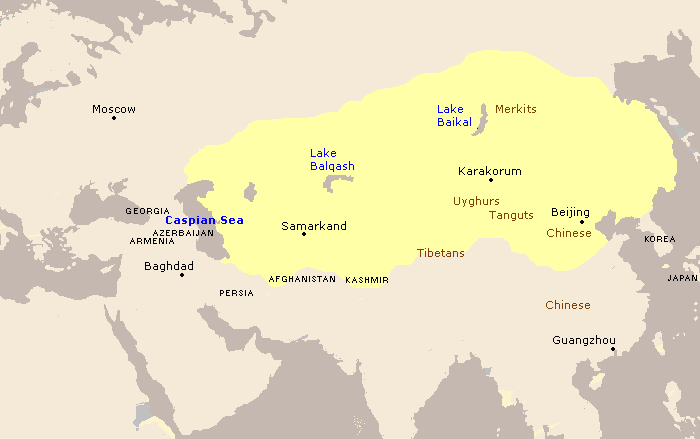 |
| mongol empire |
Commanding a military force that never amounted to
more than 200,000 troops, this Mongol ruler had united the disparate, nomadic
Mongol tribes and initiated the conquest of territory stretching from Korea
to Hungary
and from Russia
to modern Vietnam
and Syria.
His
title was Genghis Khan, “Khan of All Between the Oceans.”
Genghis Khan and his descendants could not have
conquered and ruled the largest land empire in world history without their
diminutive but extremely hardy steeds.
 |
| mongolian ponies1_Deborah Kalin |
In
some respects, these Mongolian ponies resembled what is now known as
Przewalski’s horse. Mongols held these horses in highest regard and accorded
them great spiritual significance.
 |
| mongolian ponies2_Deborah Kalin |
Before setting forth on military
expeditions, for example, commanders would scatter mare’s milk on the earth to
insure victory. In shamanic rituals, horses were sacrificed to provide
“transport” to heaven.
 |
| Mongol Cavalrymen |
The Mongols prized their horses
primarily for the advantages they offered in warfare.
In combat, the horses
were fast and flexible, and Genghis Khan was the first leader to capitalize
fully on these strengths.
After hit-and-run raids, for example, his horsemen
could race back and quickly disappear into their native steppes.
 |
| Mounted Archers |
Enemy armies from the sedentary
agricultural societies to the south frequently had to abandon their pursuit
because they were not accustomed to long rides on horseback and thus could not
move as quickly. Nor could these farmer-soldiers leave their fields for
extended periods to chase after the Mongols.
| Mongol_soldiers_mongol bow__by_Rashid_al-Din_1305 |
The Mongols had developed a composite bow made out of sinew and
horn and were skilled at shooting it while riding, which gave them the upper
hand against ordinary foot soldiers.
 |
| composite bow |
With a range of more than 350 yards, the
bow was superior to the contemporaneous English longbow, whose range was only
250 yards.
| MONGOLIAN BOW 1-1 |
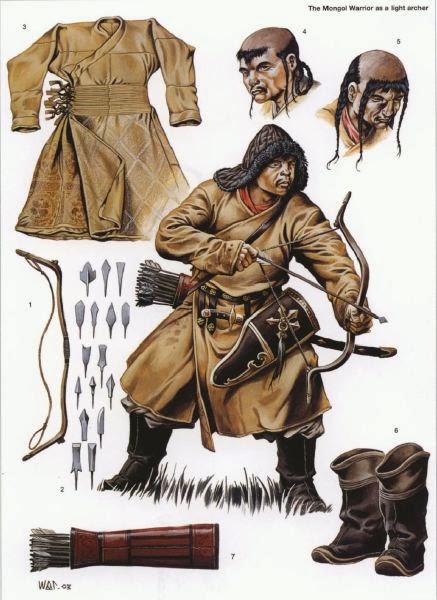 |
| Mongol light horse archer.Equipped with a deadly composite bow and armour piercing arrows |
 |
| Mongol light horse archer |
A
wood-and-leather saddle, which was rubbed with sheep’s fat to prevent cracking
and shrinkage, allowed the horses to bear the weight of their riders for long
periods and also permitted the riders to retain a firm seat.
 |
| Mongol Heavy cavalry.Well equipped with steel lamellar armour his main weapons were the lance[not shown],sabre and mace |
Their saddlebags
contained cooking pots, dried meat, yogurt, water bottles, and other essentials
for lengthy expeditions. Finally, a sturdy stirrup enabled horsemen to be
steadier and thus more accurate in shooting when mounted.
 |
| Ilkhanid Horse Archer |
A
Chinese chronicler recognized the horse’s value to the Mongols, observing that
“by nature they [the Mongols] are good at riding and shooting.
Therefore they
took possession of the world through this advantage of bow and horse.”
 |
| Mongol Archer |
Genghis Khan understood the importance
of horses and insisted that his troops be solicitous of their steeds. A cavalryman
normally had three or four, so that each was, at one time or another, given a
respite from bearing the weight of the rider during a lengthy journey.
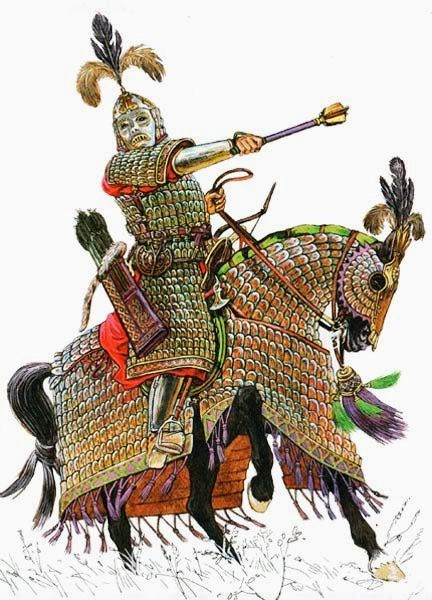 |
| A mongol Elite cavalryman or commander.Magnificently equipped in steel lamellar armour. |
Before
combat, leather coverings were placed on the head of each horse and its body
was covered with armor. After combat, Mongol horses could traverse the most
rugged terrain and survive on little fodder.
 |
| il-Khan Hulagu rests |
According to Marco Polo,
the horse also provided sustenance to its rider on long trips during which all
the food had been consumed.
On such occasions, the rider would cut the horse’s
veins and drink the blood that spurted forth.
Marco Polo reported, perhaps with
some exaggeration, that a horseman could, by nourishing himself on his horse’s
blood, “ride quite ten days’ marches without eating any cooked food and without
lighting a fire.”
And because its milk offered additional sustenance during
extended military campaigns, a cavalryman usually preferred a mare as a mount.
The milk was often fermented to produce kumiss, or araq, a potent alcoholic
drink liberally consumed by the Mongols. In short, as one commander stated, “If
the horse dies, I die; if it lives, I survive.”
Mongol
Military Tactics and Exploration
Mobility and surprise characterized the
military expeditions led by Genghis Khan and his commanders, and the horse was
crucial for such tactics and strategy.
Horses could, without
exaggeration, be referred to as the intercontinental ballistic missiles of the
thirteenth century.
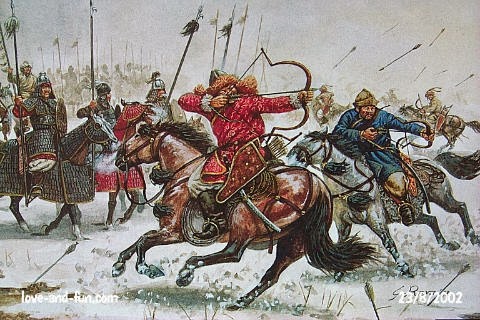 |
| The Mongols at the battle of the Kalka. |
The battle of the Kalka River, now renamed the Kalmyus
River, in southern Russia is a good example of the kind of campaign Genghis
Khan waged to gain territory and of the key role of horses.
 |
| The Battle of Kalka River 1223 AD |
After his relatively easy
conquest of Central Asia from 1219 to 1220, Genghis Khan had dispatched about
30,000 troops led by Jebe and Subedei, two of his ablest commanders, to conduct
an exploratory foray to the west. After several skirmishes in Persia, the
advance forces reached southern Russia.
 |
| PHASE 1 Russian Advance |
In an initial engagement, the Mongols,
appearing to retreat, lured a much larger detachment of Georgian cavalry on a
chase. When the Mongols sensed that the Georgian horses were exhausted, they
headed to where they kept reserve horses, quickly switched to them, and charged
at the bedraggled, spread-out Georgians. Archers, who had been hiding with the
reserve horses, backed up the cavalry—with a barrage of arrows as they routed
the Georgians.
Continuing their exploration, the
Mongol detachment crossed the Caucasus Mountains, a daunting expedition during
which many men and horses perished. They wound up just north of the Black Sea
on the southern Russian steppes, which offered rich pasture lands for their
horses.
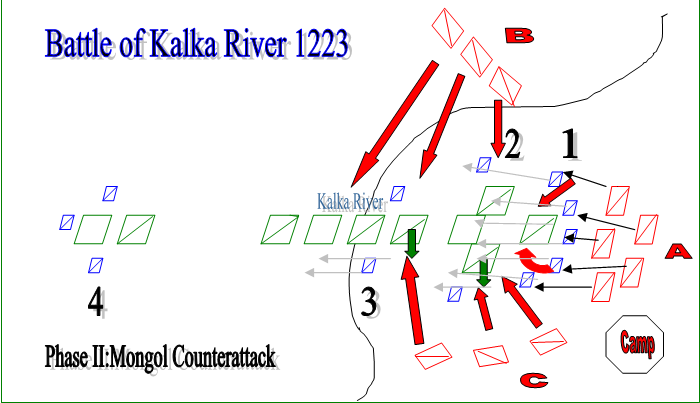 |
| PHASE 2 Mongol Counterattack. |
After a brief respite, they first
attacked Astrakhan to the east and then raided sites along the Dniester and
Dnieper Rivers, inciting Russian retaliation in May of 1223 under Mstislav the
Daring, who had a force of 80,000 men. Jebe and Subedei commanded no more than
20,000 troops and were outnumbered by a ratio of four to one.
Knowing that an
immediate, direct clash could be disastrous, the Mongols again used their
tactic of feigned withdrawal. They retreated for more than a week, because they
wanted to be certain that the opposing army continued to pursue them but was
spaced out over a considerable distance.
 |
| PHASE 3 Allied Collapse |
At the Kalka River, the Mongols finally took a stand, swerving
around and positioning themselves in battle formation, with archers mounted on
horses in the front.
The Mongols’ retreat seems to have
lulled the Russians into believing that the invaders from the East were in
disarray. Without waiting for the remainder of his army to catch up and without
devising a unified attack, Mstislav the Daring ordered the advance troops to
charge immediately.
This decision proved to be calamitous. Mongol archers on
their welltrained steeds crisscrossed the Russian route of attack, shooting
their arrows with great precision. The Russian line of troops was disrupted,
and the soldiers scattered.
After their attack, the archers turned
the battlefield over to the Mongol heavy cavalry, which pummeled the already
battered, disunited, and scattered Russians.
Wearing an iron helmet, a
shirt of raw silk, a coat of mail, and a cuirass, each Mongol in the heavy
cavalry carried with him two bows, a dagger, a battleax, a twelve-foot lance,
and a lasso as his principal weapons. Using lances, the detachment of heavy
cavalry rapidly attacked and overwhelmed the Russian vanguard, which had been
cut off from the rest of their forces in the very beginning of the battle.
Rejoined by the mounted
archers, the combined Mongol force mowed down the straggling remnants of the
Russian forces. Without an escape route, most were killed, and the rest,
including Mstislav the Daring, were captured.
Rather than shed the blood
of rival princes—one of Genghis Khan’s commands—Jebe and Subedei ordered the
unfortunate commander and two other princes stretched out under boards and
slowly suffocated as Mongols stood or sat upon the boards during the victory
banquet.
The battle at the Kalka River
resembled, with some slight deviations, the general plan of most of Genghis
Khan’s campaigns.
 |
| Statue of Ghengis Khan in Sükhbaatar Square FullMogul-wiikimedia-commons |
In less than two decades, Genghis Khan had, with the support
of powerful cavalry, laid the foundations for an empire that was to control and
govern much of Asia in the thirteenth and fourteenth centuries.
He died on a campaign in Central Asia,
and his underlings decided to return his corpse to his native land. Any
unfortunate individual who happened to encounter the funeral cortege was
immediately killed because the Mongols wished to conceal the precise location
of the burial site.
At least forty horses were reputedly
sacrificed at Genghis Khan’s tomb; his trusted steeds would be as important to
him in the afterlife as they had been during his lifetime.
 |
| genghis khan Chinggis Khaan statue horse equestrian mongolia 12 |
 |
| Genghis Khan Equestrian Statue, Tsonjin Boldog, Mongolia |
RELATED REFERENCE:
*original post date Dec 2008
Sources:
Morris Rossabi
lacma.org/khan
en.wikipedia.org/wiki/Genghis_Khan
nhmag.com/master
defence.pk
commons.wikimedia.org
deborahkalin.com
flickr
lacma.org/khan
en.wikipedia.org/wiki/Genghis_Khan
nhmag.com/master
defence.pk
commons.wikimedia.org
deborahkalin.com
flickr
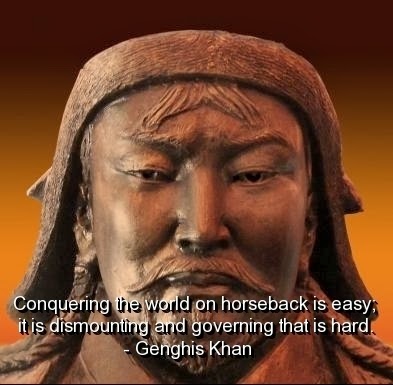
.jpg)



magnificient cruelty
ReplyDeleteIndeed...
ReplyDeleteEmpire straddled half the world
driven by vicious ambition, greed,
and a love for his horses:
e.g. his conquest of China
for the simple reason
just to look for greener
grass pasteurs
for his horses.